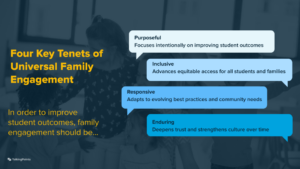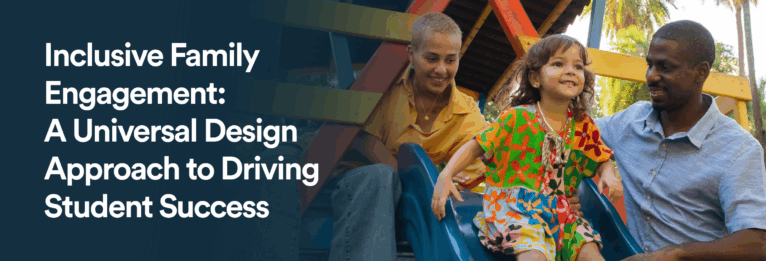Written by Kate Pechacek
Universal Family Engagement defined
Universal Family Engagement is the practice of improving outcomes for all students by fostering effective partnerships between schools and families. Universal family engagement removes barriers to in-person and digital engagement with all families, including barriers related to capacity, mindset/confidence, culture, language, technology, and time. To be successful, educators must build trusting relationships with families through consistent, asset-based interactions, where they capitalize on families as the student’s first teacher, strongest advocate, and student expert. Schools that harness the superpower of effective family partnerships can significantly accelerate the impact of their efforts to improve student learning and development.
The four tenets of Universal Family Engagement

To be effective, family engagement practices need to adhere to four foundational tenets:
Purposeful – guided by research-based best practices with an intentional focus on improving student outcomes and embedded as a strategy in a school system’s outcome-focused initiatives.
Inclusive – built with universal design principles to ensure access for all families, especially those who are hardest to reach and underserved, by addressing and overcoming barriers.
Enduring – focused on deepening mutual trust, building teacher and family capacity, and strengthening school culture through sustained and reliable engagement across teachers, staff, and schools.
Responsive – adaptive to evolving student and family needs, as well as new research on proven family engagement best practices, emphasizing flexibility to align with a school district’s changing structure and community needs.
When these four conditions are systematically in place across a school district, research shows that student performance improves and school systems become more effective.
Tenet #2 – Inclusive family engagement
When a school district applies universal design principles to family engagement, the result is better engagement with and for all families, which supports better outcomes for all students, with the added benefit of even greater gains for historically disadvantaged students.
Universal design step 1
Applying universal design begins with identifying the hardest-to-reach families and then the barriers for those families, leading to a lack of engagement. The following are some of the most common barriers to engagement.

Universal design step 2
The next step in universal design for family engagement is to identify tools or resources that will help a family overcome the barrier or provide the family a bridge to engagement despite the barrier. The following demonstrates potential barrier removers for each of the most common barriers described above.

Universal design step 3
Make all barrier removers universally available to families so any family that experiences a barrier, either temporarily or permanently, always has access to the tools they need to engage.
It is important to remember that when you approach family engagement through a universal design lens, to be inclusive, you also shift the mindsets of school staff. Without this inclusive approach, unresponsive families are sometimes seen as caring less about their children’s school or their learning. With an inclusive approach, schools address engagement barriers to ensure each student benefits from the care each family naturally has for their child.
TalkingPoints supports inclusive engagement through embedded barrier removers. Such features include defaulting every family to text messaging without them needing to opt in and the highest quality K12 contextualized translation into 150 languages. Learn more about all of the features TalkingPoints has specifically designed with inclusivity as a goal.
The impact of the use of the TalkingPoints platform has been validated by rigorous, externally validated causal research showing TalkingPoints leads to higher academic performance, lower absenteeism, and gap closure in both areas.
![]()
TalkingPoints has the power to improve outcomes in your district! To learn more about our Universal Family Engagement platform and effective family engagement strategies, visit TalkingPoints.



